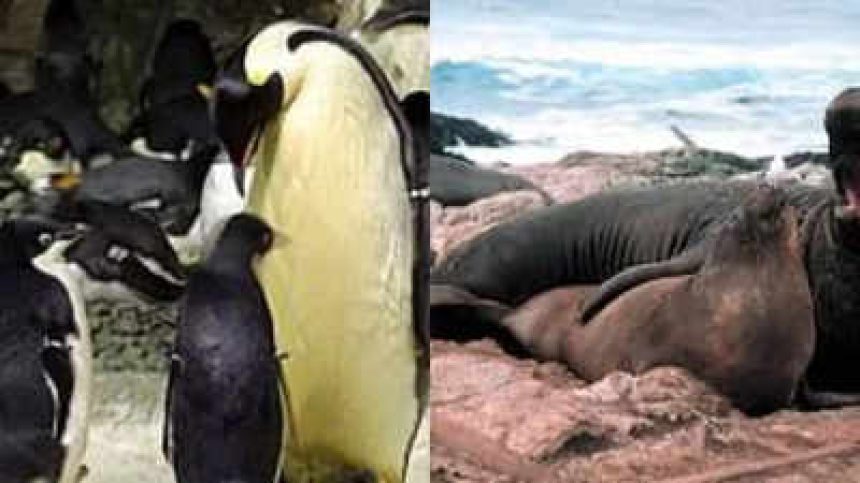Although the continent of Antarctica is usually described as a hostile, frozen wilderness, surprisingly unique animals exist that have adapted to its extreme conditions. Indeed, although this is a frozen land with no terrestrial mammals, there is a wonderful array of species, many of which are specifically adapted to survive the extreme conditions. Despite the challenges posed by freezing temperatures and icy terrain, these animals exhibit fascinating survival strategies. From creatures that thrive in the frigid waters to those that navigate the icy landscape, Antarctica’s wildlife plays a crucial role in the ecosystem. In this article, we’ll explore seven unique species found in Antarctica, highlighting their incredible adaptations and the role they play in this isolated and extreme environment.
7 animals that thrive in harsh conditions of Antarctica
Leopard seals
Leopard seals (Hydrurga leptonyx) are among Antarctica’s top predators, known by their spotted coats, which have the pattern of a leopard’s skin. The seals are exceptional hunters, recognized for their strength and versatility in catching prey. Although a large proportion of their diet is made up of Antarctic krill, they are unique because they also prey on other marine mammals, such as other species of seals. This carnivorous nature makes them different from many other seals that feed on fish or krill. Leopard seals are very efficient at hunting in both water and on ice, and their ability to tackle a wide range of prey makes them one of the most powerful predators in the Antarctic ecosystem. Their hunting strategy and adaptability make them the apex predators in this harsh environment.

Southern elephant seal
The largest seal in Antarctica is the southern elephant seal, named after its distinctive bulging snout, which has the shape of an elephant’s trunk. Mating among the elephant seals is highly competitive as males can grow up to almost 8,000 pounds. Only the strongest males get a chance to mate since they have to fight off other males for dominance. Once the males establish dominance, they form harems that can reach over 100 females. However, only about 10% of males are successful in securing a harem, making the competition fierce. This intense mating behavior highlights the struggle for dominance and reproductive success in the harsh environment of Antarctica, where strength and endurance are essential for survival and procreation.

Emperor penguin
The Emperor penguin is the largest penguin species and is only found in Antarctica. They are very tall, growing up to four feet tall and weighing as much as 100 pounds. The Emperor penguins are adapted specifically to the cold environment. The high bone density of the penguins allows them to swim very fast and even dive up to 600 feet in search of food. It’s worth noting that the world record for an observed dive is as deep as 1,700 feet. This amazing ability lets them survive in the frigid waters of Antarctica and is one of the most impressive species in the region.

Hourglass dolphin
The hourglass dolphin (Lagenorhynchus cruciger) is an outstandingly marked marine mammal. Their white markings are hourglass-shaped, standing out on the side against a generally black background. This species can be found in only sub-Antarctic and Antarctic seas. In the icy waters, the animals glide along very comfortably. These dolphins, so it is often said, are dressed up in tuxedos. Hourglass dolphins usually swim in the number of about eight, but there have been few records of groups with more than 100. Obviously, their social nature combined with the rather striking patterns on their bodies make them one of the most exciting species to be found in the Antarctic marine ecosystem.

Wandering albatross
Many species of albatross exist, with the most abundant and widespread species being the wandering albatross (Diomedea exulans). These beautiful seabirds boast the largest wingspans for any bird, as extensive as 11 feet, where they are particularly renowned for their exceptional ability to glide; frequently, a wandering albatross will soar for hours without flapping their wings to provide lift. This fantastic energy-efficient flight allows them to cover vast distances across the Southern Ocean. Its impressive wingspan and gliding skills make it one of the most iconic and well-adapted seabirds across the Antarctic region, perfectly suited to the vast, open waters of the Southern Hemisphere.

Hairy yeti crab
The hairy yeti crab, Kiwa hirsuta, is one of the most interesting crustaceans discovered in 2005. It is a kind of squat lobster covered with pale, hair-like bristles, which assist in collecting its main food source, bacteria. Its unique features make this species interesting within the Antarctic ecosystem. Another species that is quite similar to this, Kiwa tyleri, or the “yeti crab,” lives near deep-sea hydrothermal vents. This deep-sea squat lobster is particularly adapted to the harsh conditions surrounding these vents, where it feeds on bacteria thriving in extreme temperatures. Both species highlight the incredible adaptability of life in the deep, cold waters of the Antarctic.

Icefish
Icefish (Channichthyidae) are one of the most unique marine creatures found in the Southern Ocean, known for their colorless blood, which does not contain red blood cells and hemoglobin. This adaptation helps them survive in the freezing waters of Antarctica, where oxygen is more readily dissolved. A remarkable discovery was made just two years ago when a German research vessel surveying the Weddell Sea found a huge colony of icefish nests, estimated to cover more than 90 square miles and containing around 60 million nests. Each nest, carefully guarded by adult icefish, held approximately 1,700 eggs. This remarkable discovery throws light upon the breeding behavior of these peculiar fish and tells us about the incredible survival potential of life under the extreme conditions of the Antarctic region.

Also Read: Why do beavers slap their tail? Read on to find out about their unique behaviour








